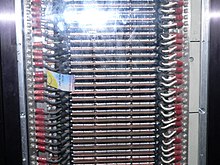Cray-1
The Cray-1 was the first supercomputer from Cray , the architecture of which was developed by Seymour Cray's team . Seymour Cray was responsible for the technology of the vector register. The first Cray-1 was commissioned in 1976 at Los Alamos National Laboratory .
history
The Los Alamos National Laboratory was awarded in 1976, the first Cray-1 for 8.8 million US dollars (equivalent to a current value of approximately $ 39.44 million) and used the supercomputer u. a. for nuclear weapon test calculations. The National Center for Atmospheric Research (NCAR) was Cray's first official commercial customer in July 1977. NCAR paid $ 8.86 million, including $ 1 million for storage. This Cray-1 was not taken out of service until 1989.
In Europe, the European Center for Medium Range Weather Forecasts ( ECMWF ) received its first cray in autumn 1978 . The center started operations in Reading near London with this Number Cruncher in 1979 with the first 10-day weather forecast.
Approximately 80 Cray-1's have been sold worldwide, priced between $ 5 million and $ 8 million. The US Air Force Systems Command (AFSC) also used a Cray-1 in the early 1980s to calculate laser developments.
In 1982 the Cray-1 was replaced by the 500 MFLOPS fast Cray X-MP , the first multiprocessor machine from Cray. In 1985 the very advanced Cray-2 came on the market. This was already able to reach 1.9 GFLOPS at the top. However, this variant was not successful, so a somewhat more conservative machine was developed as the successor to the Cray-1 and the Cray X-MP, which was sold from 1988 under the name Cray Y-MP .
description
The Cray-1 A weighed 5.5 tons including the Freon cooling system. In order to keep the cable lengths within the housing short (there were no cables longer than 1.2 meters), it had a horseshoe shape. The Cray-1A was a vector computer and included additional 200,000 specialized ECL - circuits . Equipped with a clock frequency of 80 megahertz , which was enormous for the time , 64 vector registers with a word width of 64 bits and one million very fast 64 bit memories (corresponding to 8 megabytes of RAM ), the Cray-1A achieved over 80 million floating point number operations per Second ( FLOPS ). With a later variant of the Cray-1, this value was even increased to 133 MFLOPS . Mainly because of the one million storage cells, the Cray-1A consumed 115 kW including power supply. If you add cooling, the value is almost doubled. In 1978 the first standard software package for the Cray-1 was released. It was made of
- an operating system, the Cray Operating System (COS), which was later replaced by a Cray-specific Unix variant, the UniCOS ,
- the Cray Assembler Language (CAL) and
- Cray Fortran , a Fortran - compiler , which could vectorize automatically first.
Web links
-
CRAY-1 Computer System Hardware Reference Manual , Publication No. 2240004 Rev. C 11/77 - First three chapters
(from the copy in the collection of the DigiBarn Computer Museum , [1] digitized and translated into HTML by Ed Thelen)
- Hardware Reference Guide CRAY-1S from 1981 (PDF file; 18.8 MB), from the collection of bitsavers.org (PDF file; 18.8 MB)
- Preliminary CAL Assembler Reference Manual from 1975 , from the collection of bitsavers.org (PDF file; 3.7 MB)
- Cray-1 on an FPGA with a comprehensive technical description.
Individual evidence
- ↑ This figure was based on the template: Inflation determined, rounded to a full $ 10,000 and relates to the previous January.



